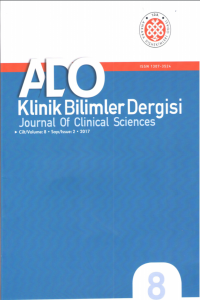Çiğneme Kası Ağrısının Yaşam Kalitesi ve Anksiyete Seviyesine Etkisi
Çiğneme Kası Ağrısı, GAD-7, OHIP-14
Effect of Masticatory Muscle Pain on Life Quality and Anxiety Level
Masticatory muscle pain, GAD-7, OHIP-14,
___
- 1.Fernandes G, Franco AL, Siqueira JT, Gonçalve DA, Camparis CM. Sleep bruxism increases the risk for painful temporomandibular disorder, depression and non-specific physical symptoms. J Oral Rehabil 2012;39:538–44.
- 2. Miloro M, Ghali GE, Larsen P, Waite P. Peterson's principles of oral and maxillofacial surgery. 2th ed. London: BC Decker; 2004. p.37
- 3. McNeill C. Management of temporomandibular disorders: concepts and controversies. J Prosthet Dent 1997;77:510-22.
- 4. Dworkin SF, LeResche L. Research diagnostic criteria for temporomandibular disorders: review, criteria, examinations and specifications, critique. J Craniomandib Disord 1992;6:301-55.
- 5. Kurt H. , Mumcu E. , Ateş M. Temporamandibular Rahatsızlıkların Teşhisinde Temporamandibular Rahatsızlıklar/Araştırma Teşhis Kriterlerinin (TMR/ATK) Kullanımı. J Istanbul Univ Fac Dent 2012; 40: 1-5.
- 6. Katon W, Roy-Byrne P. Anxiety disorders: efficient screening is the first step in improving outcomes. Ann. Med 2007;146:390-92.
- 7. Yeung E, Abou-Foul A, Matcham F, Poate T, Fan K. Integration of mental health screening in the management of patients with temporomandibular disorders. Br J Oral Maxillofac Surg 2017;55:594-99.
- 8. Donnarumma V, Ohrbach R, Simeon V, Lobbezoo F, Piscicelli N, Michelotti A. Association between waking-state oral behaviours, according to the oral behaviors checklist, and TMD subgroups. J Oral Rehabil 2021;48:996-1003.
- 9. Manfredini D, Winocur E, Ahlberg J, Guarda-Nardini L, Lobbezoo F. Psychosocial impairment in temporomandibular disorders patients. RDC/TMD axis II findings from a multicentre study. J Dent 2010;38:765-72.
- 10. Kapos FP, Look JO, Zhang L, Hodges JS, Schiffman EL. Predictors of Long-Term Temporomandibular Disorder Pain Intensity: An 8-Year Cohort Study. J Oral Facial Pain Headache 2018;32:113-22.
- 11. Kroenke K, Spitzer RL, Williams JB, Monahan PO, Löwe B. Anxiety disorders in primary care: prevalence, impairment, comorbidity, and detection. Ann Intern Med 2007;146:317-25.
- 12. Perazzo MF, Serra-Negra JM, Firmino RT, Pordeus IA, Martins-JÚnior PA, Paiva SM. Patient-centered assessments: how can they be used in dental clinical trials?. Braz Oral Res 2020;34 Suppl 2:e075.
- 13. Slade GD. Measuring oral health and quality of life. Chapel Hill: University of North Carolina 1997. p.115-17. Available from: https://www.adelaide.edu.au/arcpoh/downloads/publications/reports/miscellaneous/measuring-oral-health-and-quality-of-life.pdf
- 14. Murray H, Locker D, Mock D, Tenenbaum HC. Pain and the quality of life in patients referred to a craniofacial pain unit. J Orofac Pain 1996;10:316-23.
- 15.Slade GD. Derivation and validation of a short-form oral health impact profile. Community Dent Oral Epidemiol 1997;25:284-90.
- 16.Durham J, Steele JG, Wassell RW, et al. Creating a patient-based condition-specific outcome measure for Temporomandibular Disorders (TMDs): Oral Health Impact Profile for TMDs (OHIP-TMDs). J Oral Rehabil 2011;38:871-83.
- 17. Arifagaoglu O, Koseoglu Secgin C, Yuzugullu B. Effect of the COVID-19 pandemic on anxiety in patients with masticatory muscle pain [published online ahead of print, 2021 Sep 21]. J Prosthet Dent 2021;S0022-3913:00490-X.
- 18. Yule PL, Durham J, Playford H, et al. OHIP-TMDs: a patient-reported outcome measure for temporomandibular disorders. Community Dent Oral Epidemiol 2015;43:461-70.
- 19. Manfredini D, Marini M, Pavan C, Pavan L, Guarda-Nardini L. Psychosocial profiles of painful TMD patients. J Oral Rehabil 2009;36:193-98.
- 20. Polat S, Polat N, Çetinoğlu AOR. Diagnostic criteria for temporomandibular disorders: assessment instruments. Int RDC/TMD Consort Netw 2014
- 21. Basol ME, Karaagaçlioglu L, Yilmaz B. Türkçe agiz sagligi etki ölçeginin gelistirilmesi-OHIP-14-TR/Developing a turkish oral health impact profile-OHIP-14-TR: Turkiye Klinikleri J Med Sci 2014;20:85-92.
- 22. Kim TY, Shin JS, Lee J, et al. Gender Difference in Associations between Chronic Temporomandibular Disorders and General Quality of Life in Koreans: A Cross-Sectional Study. PLoS One 2015;10:e0145002. Published 2015 Dec 16.
- 23.Velly AM, Gornitsky M, Philippe P. Contributing factors to chronic myofascial pain: a case-control study. Pain 2003;104:491-99.
- 24. Dworkin SF, Massoth DL. Temporomandibular disorders and chronic pain: disease or illness?. J Prosthet Dent 1994;72:29-38.
- ISSN: 1307-3540
- Yayın Aralığı: Yılda 3 Sayı
- Başlangıç: 2006
- Yayıncı: Ankara Diş Hekimleri Odası
Periodontal Rejeneratif Tedavide Yeni Bir Boyut: Üç Boyutlu Hücre Kültürü
Kadriye ALTIKAT, Ayşe Emel ÖKTE
Farklı Akademik Dönemlerdeki Diş Hekimlığı Öğrencilerin Öğrenme Koşulları İle İlgili Tercihleri
Özgür İlke ULUSOY, İlke Gaye SAVUR, Arzu ŞAHİN MANTI
Hidrojen Peroksit/Kolloidal Gümüş’ün Staphylococcus aureus Üzerindeki Etkisi: Pilot Çalışma
Ayşe BULUT, Faik Serhat ÖZSOY, Gülçin AKCA, Nazime TUNCAY, Özgür Yıldırım TORUN, Ömer Engin BULUT
Diş Hekimliğinde Biyoaktif Camların Kullanımı
Ece UÇAR BAŞOL, Işıl ÇEKİÇ NAGAŞ
Kaan YERLİYURT, Hüseyin HATIRLI
Merve ÖZARSLAN, Dilber BİLGİLİ CAN
Türk toplumunda mental sinir, mental lup ve insiziv kanalın retrospektif bir değerlendirmesi
Güzin Neda HASANOGLU ERBASAR, Fatma Nur KONARILI, Orhan GÜLEN, Kevser SANCAK
TEMPOROMANDİBULER BOZUKLUKLARIN ETİYOLOJİSİNDE STRES
Esma Betül YILMAZ, Cansu ALPASLAN
Genetik Faktörlerin Diş Çürüğü Üzerine Etkisinin Değerlendirilmesi
